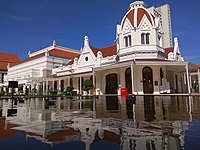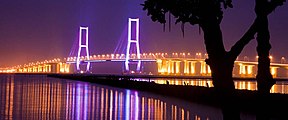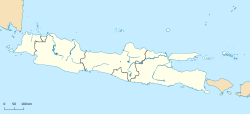
Back Surabaya ACE Surabaya Afrikaans سورابايا Arabic سورابايا ARZ Surabaya AST Surabaya Azerbaijani سورابایا AZB Сурабая Bashkir Kota Surabaya BAN Surabaya BAR
Surabaya | |
|---|---|
| City of Surabaya Kota Surabaya | |
| Other transcription(s) | |
| • Hanacaraka | ꦯꦹꦫꦨꦪ or ꦱꦸꦫꦧꦪ |
| • Pegon | كوڟا سورابايا (Pegon Java) كوَڟّا سَوربٓاجٓا (Pegon Madura) |
| • Javanese | Kutha Surabaya |
| • Madura | Koṭṭa Sorbhâjâh |
| • Chinese | 泗水 sì shuǐ (Pinyin) |
|
| |
| Nickname(s): | |
| Motto(s): Surabaya Gemilang "Sparkling Surabaya" | |
 Location within East Java | |
 | |
| Coordinates: 07°14′45″S 112°44′16″E / 7.24583°S 112.73778°E | |
| Country | |
| Region | Java |
| Province | |
| Settled | 1037[1] |
| Founded | 31 May 1293[2] |
| Incorporated | 1 April 1906 (as Gemeente)[3] |
| Government | |
| • Mayor | Eri Cahyadi (PDI-P) |
| • Vice Mayor | Armuji |
| Area | |
| • City | 350.56 km2 (135.35 sq mi) |
| • Urban | 911 km2 (352 sq mi) |
| • Metro | 5,925 km2 (2,288 sq mi) |
| Elevation | 5 m (16 ft) |
| Population (mid 2023 estimate[4]) | |
| • City | 3,009,286 (2nd) |
| • Urban | 6,998,000 (3rd) |
| • Urban density | 7,134/km2 (18,480/sq mi) |
| • Metro | 9,924,509 (2nd) |
| • Metro density | 1,615/km2 (4,180/sq mi) |
| Demonyms | Surabayan |
| Demographics | |
| • Ethnic groups | Javanese, Madurese, Sundanese, Minangkabau, Batak, Banjar, Balinese, Bugis, Malay, Chinese, Indian, Arabs |
| • Religion[7] | Islam 82.49% Christianity 15.81% — Protestantism 11.90%% — Catholicism 3.91%% Buddhism 1.42% Hinduism 0.25% Confucianism 0.02% Others 0.01% |
| Time zone | UTC+07:00 |
| Postal Code | 60111 – 60299 |
| Area code | (+62) 31 |
| Vehicle registration | L |
| Nominal GDP[8] | 2019 |
| - Total | Rp 580.7 trillion (2nd) $ 41.1 billion $ 135.0 billion (PPP) |
| - Per capita | Rp 200,505 thousand (5th) $ 14,180 $ 46,610 (PPP) |
| - Growth | |
| Airport | Juanda International Airport |
| Commuter rail | |
| Bus rapid transit | Trans Semanggi Suroboyo |
| Website | surabaya.go.id |
Surabaya (Javanese: ꦱꦸꦫꦧꦪ or ꦯꦹꦫꦨꦪ; pronounced [surɔbɔjɔ]; Indonesian: [suraˈbaja] ⓘ, Van Ophuijsen Spelling: Soerabaja) is the capital city of the Indonesian province of East Java and the second-largest city in Indonesia, after Jakarta. Located on the northeastern corner of Java island, on the Madura Strait, it is one of the earliest port cities in Southeast Asia. According to the National Development Planning Agency, Surabaya is one of the four main central cities of Indonesia, alongside Jakarta, Medan, and Makassar.[9][10] The city had a population of 2,874,314 within its city limits at the 2020 census.[11] With 3,009,286 people living in the city as of mid 2023 (comprising 1,490,358 males and 1,518,928 females) [4] and over 10 million in the extended Surabaya metropolitan area, according to the latest official estimate, Surabaya was the second-largest metropolitan area in Indonesia.[12] Surabaya metropolitan is also ASEAN's 7th largest economy ahead of Hanoi.
The city was settled in the 10th century by the Kingdom of Janggala, one of the two Javanese kingdoms that was formed in 1045 when Airlangga abdicated his throne in favor of his two sons. In the late 15th and 16th centuries, Surabaya grew to be a duchy, a major political and military power as well as a port in eastern Java, probably under the Majapahit empire.[13] At that time, Surabaya was already a major trading port, owing to its location on the River Brantas delta and the trade route between Malacca and the Spice Islands via the Java Sea. During the decline of Majapahit, the lord of Surabaya resisted the rise of the Demak Sultanate and only submitted to its rule in 1530.[14][15] Surabaya became independent after the death of Sultan Trenggana of Demak in 1546.[16][17]
From the 18th century until the mid-20th century, Surabaya was the largest city in the Dutch East Indies and the main trading hub for the Indonesian archipelago, competing with Shanghai and Hong Kong.[13]
The city is referred to as Kota Pahlawan (the city of heroes) due to the significance of the Battle of Surabaya during the Indonesian National Revolution. The city is one of the important financial, commercial, industrial, transportation, and entertainment hubs of the archipelago.[18] Arguably the second most significant city after Jakarta, the city is also home to Indonesia's second-busiest seaport, the Port of Tanjung Perak, which is located in northern Surabaya. The city is also known for being one of the cleanest and greenest in Indonesia.[citation needed]
Surabaya has been one of the busiest trading city ports in Asia.[19] Principal exports from the port include sugar, tobacco, and coffee.[20] Its rich history as a trading port has led to a strong financial infrastructure with financial institutions such as banks, insurance, and export-import companies. The economy is influenced by the recent growth in international industries and the completion of the Suramadu Bridge. The city is home to a large shipyard and numerous specialized naval schools.[21] The Bank of Indonesia has also made plans for Surabaya to be the Islamic financial center of Indonesia.[22][23]
- ^ Munoz, Paul Michel (2006). Early Kingdoms of the Indonesian Archipelago and the Malay Peninsula. Continental Sales, Incorporated. p. 246. ISBN 9789814155670.
- ^ "Pasar Keputran Utara | Pasar Surya".
- ^ Perkembangan Kota Dan Arsitektur Kolonial Belanda Di Surabaya, 1870–1940. Diterbitkan atas kerjasama Lembaga Penelitian dan Pengabdian kepada Masyarakat, Universitas Kristen PETRA Surabaya dan Penerbit ANDI Yogyakarta. 1 January 1996. ISBN 9789795333739 – via Google Books.
- ^ a b Badan Pusat Statistik, Jakarta, 28 February 2024, Kota Surabaya Dalam Angka 2024 (Katalog-BPS 1102001.3578)
- ^ "Demographia World Urban Areas, 18th Annual Edition" (PDF). July 2022. Retrieved 29 March 2023.
- ^ "PU-net". perkotaan.bpiw.pu.go.id. Archived from the original on 11 April 2022. Retrieved 31 August 2020.
- ^ Statistics Indonesia. "Surabaya Municipality in Figures 2017". surabayakota.bps.go.id. Archived from the original on 1 April 2019. Retrieved 1 April 2019.
- ^ "BPS Provinsi Jawa Timur". jatim.bps.go.id.
- ^ "26. Z. Irian Jaya". bappenas.go.id (Word DOC) (in Indonesian).
- ^ Geografi. Grasindo. p. 114. ISBN 978-979-759-619-4.
- ^ Badan Pusat Statistik, Jakarta, 2021.
- ^ "Indonesia: Java (Regencies, Cities and Districts) – Population Statistics, Charts and Map".
- ^ a b Dick, Howard W. (2003). Surabaya, City of Work: A Socioeconomic History, 1900–2000. Research in international studies: Southeast Asia series. Vol. 106. Singapore University Press. ISBN 978-9971-69-264-3.
- ^ Pigeaud 1976, p. 16.
- ^ Ricklefs 2008, p. 39.
- ^ Pigeaud 1976, p. 28.
- ^ Akhmad Saiful Ali 1994, p. 32.
- ^ "Surabaya Siap Jadi Penghubung Perdagangan Indonesia Timur". Republika Online (in Indonesian). 17 November 2017. Retrieved 6 March 2019.
- ^ "Surabaya History Facts and Timeline: Surabaya, East Java, Indonesia". www.world-guides.com. Retrieved 27 January 2019.
- ^ Zanden, Jan Luiten van; Marks, Daan (2 May 2013). An Economic History of Indonesia: 1800–2010. Routledge. ISBN 978-1-136-45460-8.
- ^ surabaya.go.id. "Sosial Ekonomi". www.surabaya.go.id (in Indonesian). Retrieved 5 January 2019.
- ^ Primadhyta, Safyra. "Teror Bom, BI Pastikan Surabaya Jadi Pusat Ekonomi Syariah". ekonomi. Retrieved 5 January 2019.
- ^ Indonesia, Rima News. "Surabaya Pusat Ekonomi Syariah di Indonesia". Rimanews.com (in Indonesian). Archived from the original on 5 January 2019. Retrieved 5 January 2019.
© MMXXIII Rich X Search. We shall prevail. All rights reserved. Rich X Search









